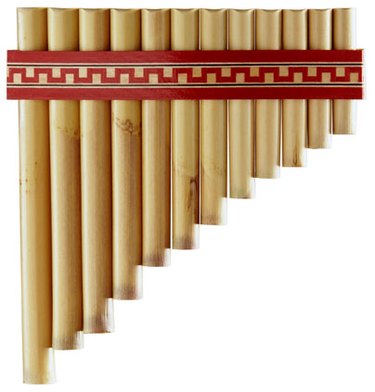Things You'll Need
2 feet of 1/2-inch/schedule-40 PVC sprinkler pipe
Hacksaw
Five pennies
Duct tape
Scissors
Fine sandpaper

A simple way to bring more music into your life is by making your own musical instrument. Creating music is one of the basic human skills and music is especially important in early childhood development; according to Harvard psychologist Howard Gardner, music education is as important as math, logic and literacy. Making a musical instrument with five notes, such as a panpipe, is a simple project that will help your child's cognitive development and musical enjoyment.
Step 1
Cut the PVC piping into five sections with a hacksaw. The first section should be 6 1/16 inches, the second should be 5 3/8 inches, the third should be 4 3/4 inches, the fourth should be 3 15/16 inches and the fifth should be 3 7/16 inches.
Video of the Day
Step 2
Place a penny over the end of one PVC pipe that you have cut. Cover and secure it with a piece of duct tape, approximately 2 by 2 inches. Repeat for the other four cut pipes.
Step 3
Sand the other end of the pipes with fine-grit sandpaper until they are smooth to the touch. These are the ends you will be blowing into so they should be smooth.
Step 4
Set all the cut pipes on a table from the largest to the smallest. Wrap them with duct tape around the middle to secure them together.
Step 5
Blow across the opening of the pipes while holding the panpipes in your hands. The largest pipe should be in your right hand, and the smallest in your left hand. Blow as if you are blowing across a soda bottle opening.
Tip
The longest pipe is the C note, the second is D, the third is E, the fourth is G, and the shortest is A.
The longer the pipe is the lower the pitch will be, and the shorter the pipe, the higher the pitch.
Experiment with different sizes to make a larger panpipe.
Warning
Adult supervision is needed when sawing.
Video of the Day